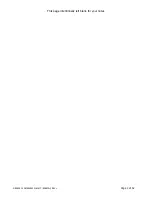
NRP620-10 OMEPAPV20161017 (ENGLISH) REV 1
Page 13 of 42
Combustion Air Requirements
Install the A-Maize-Ing Heat® furnace in a room with adequate air for combustion and ventilation - 60
cubic feet per minute minimum.
Fans installed in the storage area should not create negative pressures in the room where the solid
fuel-burning appliance is located.
Outside combustion air may be necessary if:
1.
The solid-fuel-fired appliance does not draw steadily, smell, experiences smoke roll-out, burns
poorly, or back-drafts whether or not there is combustion present.
2.
Any of the above symptoms are alleviated by opening a window slightly on a calm day.
3.
The house is equipped with a well-sealed vapor barrier and tight fitting windows and/or has any
powered devices which exhaust house air.
4.
There is excessive condensation on windows in the winter.
5.
A ventilation system is installed in the house.
Venting
WARNING
Failure to provide correct chimney venting can lead to an increase in carbon monoxide and
combustion gases into the building resulting in death, serious injury, and/or property
damage.
Connect the A-Maize-Ing Heat® furnace to a lined masonry chimney acceptable to the authority having
jurisdiction. USA installation may also use a residential type Class A and building heating appliance
chimney. Do not connect the A-Maize-Ing Heat® furnace to any chimney flue servicing any other
heating appliance, as recommended by the National Fire Prevention Association. All chimney
connections must meet the approval of the local building inspector and fire marshal and conform to all
local, state, provincial, and national codes.
The furnace is intended for connection to chimneys for residential and building heating appliances in
compliance with the Standard for Chimneys, Fireplaces, Vents, and Solid Fuel Burning Appliances, NFPA
211, and intended for installation in compliance with the Standard for Installation of Warm Air Heating
and Air Conditioning Systems, NFPA 90B; and the National Electrical Code, ANSI/NFPA 70; and
applicable mechanical codes such as the BOCA National Mechanical Code, the Standard Mechanical
Code, and the Uniform Mechanical Code.
The site of the installation should be located in an area that is not too close to neighbors or in valleys
that would cause unhealthy air quality or nuisance conditions.
Draft is the force which moves air from the appliance up through the chimney. The amount of draft in
your chimney depends on the length of the chimney, local geography, nearby obstructions and other
factors. Too much draft may cause excessive temperatures in the appliance and may damage the
appliance. Inadequate draft may cause back puffing into the room and ‘plugging’ of the chimney.
Inadequate draft will cause the appliance to leak smoke into the room through appliance and chimney
connector joints. An uncontrollable burn or excessive temperature indicates excessive draft.
















































